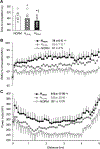On the Influence of Group III/IV Muscle Afferent Feedback on Endurance Exercise Performance
- PMID: 32658041
- PMCID: PMC7492373
- DOI: 10.1249/JES.0000000000000233
On the Influence of Group III/IV Muscle Afferent Feedback on Endurance Exercise Performance
Abstract
This review discusses evidence suggesting that group III/IV muscle afferents affect locomotor performance by influencing neuromuscular fatigue. These neurons regulate the hemodynamic and ventilatory response to exercise and, thus, assure appropriate locomotor muscle O2 delivery, which optimizes peripheral fatigue development and facilitates endurance performance. In terms of central fatigue, group III/IV muscle afferents inhibit motoneuronal output and thereby limit exercise performance.
Conflict of interest statement
Figures




